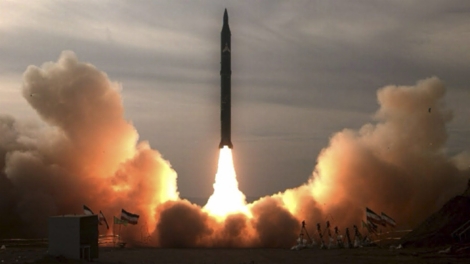
In “Surat al-Fil” (“The Elephant”)–one of the Holy Qur’an’s shortest chapters–God sends a flock of birds to destroy the followers of Sultan Abraha, because of their plot to destroy the Kaaba, a holy monument in the center of Mecca that was built by Father Abraham himself. God equips the birds with baked clay stones, which they hurled at the Elephants of Sultan Abraha, stopping his advance toward the city.
On Wednesday the Iranian Defense Ministry successfully conducted a third test of Iran’s solid-state, medium-range, ballistic missile called the Sajjil-2. In Persian, Sajji is translated as “baked clay,” serving as a powerful allusion to Surat al-Fil. With a range of 2,000 km (almost 1,200 miles), the state of Israel, US bases in the Persian Gulf, and parts of southern Europe are within range of an Iranian strike.
Iranian Defense Minister Gen. Ahmad Vahidi vowed that the Sajjil-2 would be a “strong deterrent” against any possible foreign attack, stating, “Given its high speed, it is impossible to destroy the missile with anti-missile systems because of its radar-evading ability.”
The Sajjil-2 made its debut in May and was tested for a second time in September. Both tests reveal several improvements from its predecessor, the Sajjil-1. The current model houses a more advanced navigation system and operates entirely on solid fuel, both of which make the missile incredibly accurate. In addition, its solid fuel propellant can be constructed in advance and moved or hidden with relative ease.
The launch comes just days after a “confidential memo” leaked to The Times of London reported that Iranian scientists are completing tests on a neutron initiator, the mechanism in a bomb that causes the initial explosion.
Iran’s domestic production of military hardware began after the conclusion of its decade-long war with Iraq in the 1980s. Since the mid-1990s, the Islamic Republic has produced its own armored vehicles, fighter aircraft, and missile systems. The capability of such weapons systems is difficult to ascertain, however, because they have not seen any significant action in 20 years.
In response to Iranian dithering over an IAEA-sponsored nuclear fuel swap deal with Russia, the US House of Representatives voted last week for a new regimen of petroleum sanctions. Some defense analysts, like AEI’s Danielle Pletka, say that creative sanctions can weaken the regime without hurting everyday Iranians. Opponents of harsh sanctions, such as Rep. Ron Paul, argue that the move will place a burden on Iranian society, causing people to turn to the regime for support. That argument maintains that the “rally ’round the flag” effect in Iran would not only undermine Western efforts at blocking Iran, but would also weaken opponents of the Ahmadinejad government.
The moral of “Surat al-Fil” is that no plot of man can succeed against an Almighty God. The moral of the standoff between the West and Iran over Iranian nuclear proliferation has yet to be written.
Are you a dedicated reader of FDD's Long War Journal? Has our research benefitted you or your team over the years? Support our independent reporting and analysis today by considering a one-time or monthly donation. Thanks for reading! You can make a tax-deductible donation here.








1 Comment
The “capabilities” of the Iranian built Zulfiqar tank are not all that difficult to ascertain. It’s cobbled together from parts of the M-48, M-60, and T-72. It weighs around 30 tons. It has a welded steel turret. Only the prototypes have been seen in public. No production versions have been seen so far.
The Iranian “produced” fighter aircraft are of similar production values. The Saegeh-80 in particular is little more then a highly modified F-5.
I suspect the Mullah’s model rocket club may be a bit more advanced then those other Iranian military projects are.
OTHER
WISE,
R